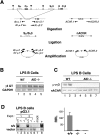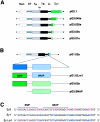Mapping of a functional recombination motif that defines isotype specificity for mu-->gamma3 switch recombination implicates NF-kappaB p50 as the isotype-specific switching factor
- PMID: 14993249
- PMCID: PMC2213297
- DOI: 10.1084/jem.20031935
Mapping of a functional recombination motif that defines isotype specificity for mu-->gamma3 switch recombination implicates NF-kappaB p50 as the isotype-specific switching factor
Abstract
Ig class switch recombination (CSR) requires expression of activation-induced deaminase (AID) and production of germline transcripts to target S regions for recombination. However, the mechanism of CSR remains unclear. Here we show that an extrachromosomal S plasmid assay is AID dependent and that a single consensus repeat is both necessary and sufficient for isotype-specific CSR. Transfected switch substrates specific for mu-->gamma3 and mu-->gamma1 are stimulated to switch with lipopolysaccharide (LPS) alone or LPS and interleukin-4, respectively. An Sgamma3/Sgamma1 substrate containing only three Sgamma3-associated nucleotides reconstituted LPS responsiveness and permitted mapping of a functional recombination motif specific for mu-->gamma3 CSR. This functional recombination motif colocalized with a binding site for NF-kappaB p50, and p50 binding to this site was previously established. We show a p50 requirement for plasmid-based mu-->gamma3 CSR using p50-deficient B cells. Switch junctions from p50-deficient B cells showed decreased lengths of microhomology between Smu and Sgamma3 relative to wild-type cells, indicating a function for p50 in the mechanics of CSR. We note a striking parallel between the affects of p50 and Msh2 deficiency on Smu/Sgamma3 junctions. The data suggest that p50 may be the isotype-specific factor in mu-->gamma3 CSR and epistatic with Msh2.
Figures





Similar articles
-
Two new isotype-specific switching activities detected for Ig class switching.J Immunol. 2002 Mar 15;168(6):2835-46. doi: 10.4049/jimmunol.168.6.2835. J Immunol. 2002. PMID: 11884453 Free PMC article.
-
NF-kappa B p50-dependent in vivo footprints at Ig S gamma 3 DNA are correlated with mu-->gamma 3 switch recombination.J Immunol. 2001 Apr 1;166(7):4552-9. doi: 10.4049/jimmunol.166.7.4552. J Immunol. 2001. PMID: 11254712 Free PMC article.
-
NF-kappa B binds to the immunoglobulin S gamma 3 region in vivo during class switch recombination.Eur J Immunol. 2006 Dec;36(12):3315-23. doi: 10.1002/eji.200636294. Eur J Immunol. 2006. PMID: 17109470 Free PMC article.
-
Signaling control of antibody isotype switching.Adv Immunol. 2019;141:105-164. doi: 10.1016/bs.ai.2019.01.001. Epub 2019 Feb 11. Adv Immunol. 2019. PMID: 30904131 Free PMC article. Review.
-
Current insights into the mechanism of mammalian immunoglobulin class switch recombination.Crit Rev Biochem Mol Biol. 2019 Aug;54(4):333-351. doi: 10.1080/10409238.2019.1659227. Epub 2019 Sep 11. Crit Rev Biochem Mol Biol. 2019. PMID: 31509023 Free PMC article. Review.
Cited by
-
LRRK1 is critical in the regulation of B-cell responses and CARMA1-dependent NF-κB activation.Sci Rep. 2016 May 11;6:25738. doi: 10.1038/srep25738. Sci Rep. 2016. PMID: 27166870 Free PMC article.
-
AID: a very old motif newly recognized.Nat Immunol. 2004 Dec;5(12):1203-4. doi: 10.1038/ni1204-1203. Nat Immunol. 2004. PMID: 15549118 Free PMC article.
-
S-S synapsis during class switch recombination is promoted by distantly located transcriptional elements and activation-induced deaminase.Immunity. 2007 Nov;27(5):711-22. doi: 10.1016/j.immuni.2007.09.007. Epub 2007 Nov 1. Immunity. 2007. PMID: 17980632 Free PMC article.
-
Differential regulation of histone acetylation and generation of mutations in switch regions is associated with Ig class switching.Proc Natl Acad Sci U S A. 2004 Oct 26;101(43):15428-33. doi: 10.1073/pnas.0406827101. Epub 2004 Oct 14. Proc Natl Acad Sci U S A. 2004. PMID: 15486086 Free PMC article.
-
Binding of LBP-1a to specific immunoglobulin switch regions in vivo correlates with specific repression of class switch recombination.Eur J Immunol. 2009 May;39(5):1387-94. doi: 10.1002/eji.200838226. Eur J Immunol. 2009. PMID: 19384868 Free PMC article.
References
-
- Stavnezer, J. 2000. Molecular processes that regulate class switching. Curr. Top. Microbiol. Immunol. 245:127–168. - PubMed
-
- Manis, J.P., M. Tian, and F.W. Alt. 2002. Mechanism and control of class-switch recombination. Trends Immunol. 23:31–39. - PubMed
-
- Muramatsu, M., K. Kinoshita, S. Fagarasan, S. Yamada, Y. Shinkai, and T. Honjo. 2000. Class switch recombination and hypermutation require activation-induced cytidine deaminase (AID), a potential RNA editing enzyme. Cell. 102:553–563. - PubMed
-
- Muramatsu, M., V.S. Sankaranand, S. Anant, M. Sugai, K. Kinoshita, N.O. Davidson, and T. Honjo. 1999. Specific expression of activation-induced cytidine deaminase (AID), a novel member of the RNA-editing deaminase family in germinal center B cells. J. Biol. Chem. 274:18470–18476. - PubMed
-
- Revy, P., T. Muto, Y. Levy, F. Geissmann, A. Plebani, O. Sanal, N. Catalan, M. Forveille, R. Dufourcq-Labelouse, A. Gennery, et al. 2000. Activation-induced cytidine deaminase (AID) deficiency causes the autosomal recessive form of the Hyper-IgM syndrome (HIGM2). Cell. 102:565–575. - PubMed
Publication types
MeSH terms
Substances
Grants and funding
LinkOut - more resources
Full Text Sources
Molecular Biology Databases
Research Materials

